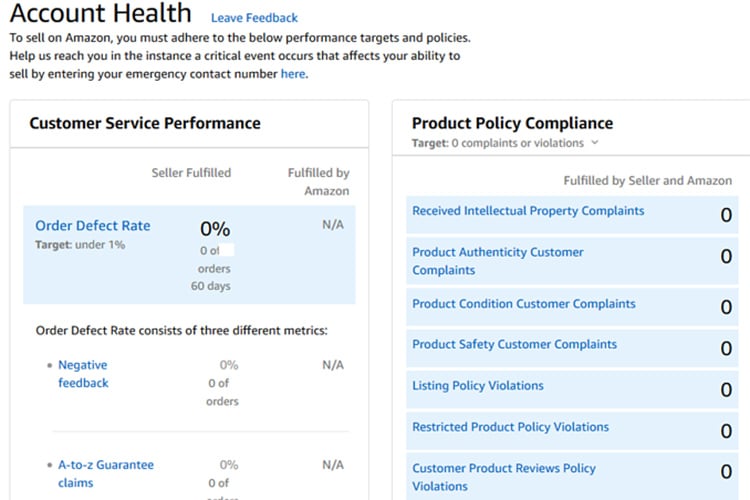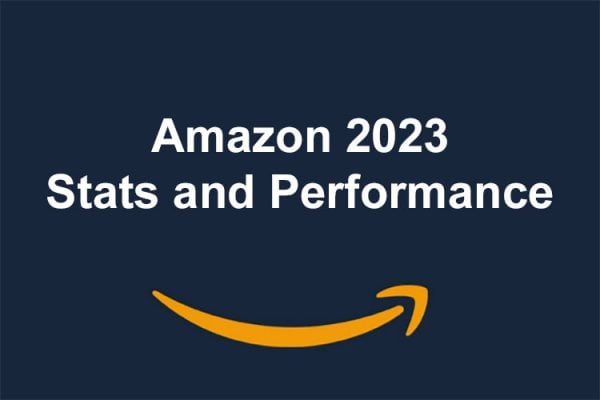Amazon have made a few changes to how you monitor your account health. To view your account health, go to the Amazon Seller Central homepage and under ‘Performance’ click on ‘Account Health’. There are six main metrics which your Amazon account health will be measured on.
It’s well known that Amazon don’t mess about if your account health falls below their standards. This could involve an account review and submitting a statement as to how you will avoid issues in the future or in some cases could result in your account being closed.
The most important three metrics to maintain are:
- Order defect rate: < 1%
- Pre-fulfillment cancel rate: < 2.5%
- Late dispatch rate: < 4%
Potential resolutions are:
- Active: Your selling account is able to sell on Amazon and funds (payments) may be disbursed as per the normal schedule.
- Under Review: Your selling account is able to sell on Amazon, but is currently under review by Amazon and funds are temporarily withheld until the review is completed.
- Suspended: Your selling account is not able to sell on Amazon and funds are temporarily withheld.
Amazon account health metrics
Order Defect Rate
The Order Defect Rate (ODR) is a key measure of your ability to provide a good customer experience. It includes all orders with one or more defects (defined below) represented as a percentage of total orders during a given 60-day time period.
An order has a defect if it results in negative feedback, an A-to-z Guarantee claim that is not denied, or a credit card chargeback.
Amazon’s policy is that sellers maintain an ODR under 1% in order to sell on Amazon. An ODR above 1% may result in account deactivation.
Cancellation Rate
The Cancellation Rate (CR) is all seller-cancelled orders represented as a percentage of total orders during a given 7-day time period. CR only applies to seller-fulfilled orders.
This metric includes all order cancellations initiated by the seller, with the exception of those requested by the customer using the order-cancellation options in their Amazon account. Pending orders that are cancelled by the customer directly on Amazon are not included.
Amazon’s policy is that sellers maintain a CR under 2.5% in order to sell on Amazon. A CR above 2.5% may result in account deactivation.
Late Dispatch Rate
The Late Dispatch Rate includes all orders with a shipping confirmation that is completed after the expected ship date. Late Dispatch Rate is represented as a percentage of total orders over both a 10-day or 30-day period. Late Dispatch Rate only applies to seller-fulfilled orders.
It is important to confirm the shipment of orders by the expected ship date so that customers can see the status of their shipped orders online. Orders that are ship confirmed late might lead to increased claims, negative feedback and/or customer contacts and negatively impact customer experience.
Amazon’s policy is that sellers maintain a Late Dispatch Rate under 4% in order to sell on Amazon. A Late Dispatch Rate above 4% can result in account deactivation.
Valid Tracking Rate
The Valid Tracking Rate (VTR) includes all shipments with a valid tracking number represented as a percentage of total shipments during a given 30-day time period. VTR only applies to seller-fulfilled orders.
Amazon say that their customers depend on tracking numbers to find out where their orders are and when they can expect to receive them. The Valid Tracking Rate is a performance metric that reflects those expectations. Most major carriers now offer free tracking.
On-Time Delivery Rate
The On-Time Delivery Rate (OTDR) includes all shipments delivered by their estimated delivery date represented as a percentage of total tracked shipments. OTDR only applies to seller-fulfilled orders.
Amazon consider OTDR performance when determining which Transit Times you are eligible to set, which may enable you to promise faster delivery times and improve your conversion.
Amazon recommend that sellers maintain an OTDR greater than 97% in order to provide a good customer experience, currently there is no penalty for not meeting this performance metric (but that could change in the future!)
Return Dissatisfaction Rate
The Return Dissatisfaction Rate (RDR) measures your customers’ satisfaction with their return experience. The return experience is negative when a return request has negative buyer feedback (Negative Return Feedback Rate), is not responded to within 48 hours (Late Response Rate), or is incorrectly denied (Invalid Rejection Rate). Your Return Dissatisfaction Rate is all negative return requests represented as a percentage of total return requests.
Amazon’s policy is that sellers maintain an RDR under 10%. As with OTDR, currently there is no penalty for not meeting this performance metric, though customers with unresolved problems are more likely to submit negative feedback and A-to-z Guarantee claims and this impacting your ODR.











One Response
Luckily I have 0 on the most important ones.
However, for Product Policy Compliance, I have a number. These are always by manufacturer’s on main distributors complaining of some alleged infringements of their rights. It is nearly always anti-competitive behaviour. Amazon of course doesn’t care and doesn’t want to be involved. I now have a policy of always contacting the complainant. As an ex lawyer, I am able to draft a letter or e-mail that does produce a response either from them or their legal team. Once there, it’s much easier to resolve the problem. The second thing I do if I cannot resolve it with the manufacturer or legal team is to report it to the appropriate national competition body.